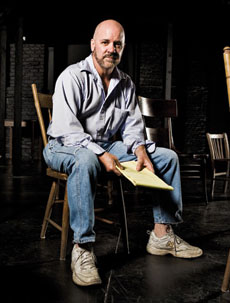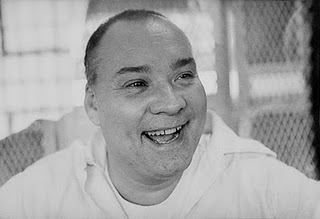Coyote on a Fence: The Origin
edited from the original article published in The Independent (UK) Thursday, March, 25 2004
American playwright Bruce Graham can pinpoint the exact moment of conception of Coyote on a Fence. At home one day in 1997, he read a story in The Philadelphia Inquirer about James Beathard, a convicted killer and editor of the Texas Death Row Journal, a tabloid published by an anti-death-penalty group, in which Beathard wrote obituaries of his fellow inmates at the prison in Huntsville, Texas. The obituaries always looked for the positive and never referred to the men's crimes, Beathard told journalists. "Everyone, even your worst enemy," he said, "deserves some honor and respect after they die."
 Graham had spent most of the previous two years working on film and TV scripts dominated by short scenes and had been looking for a story that would allow him to write long, uninterrupted stretches of dialogue. "So when I read about James Beathard trying to find something good to say about people that we all consider monsters, sometimes rightly so," he explains, "the drama of it just jumped out at me."
Graham had spent most of the previous two years working on film and TV scripts dominated by short scenes and had been looking for a story that would allow him to write long, uninterrupted stretches of dialogue. "So when I read about James Beathard trying to find something good to say about people that we all consider monsters, sometimes rightly so," he explains, "the drama of it just jumped out at me."
He wrote to Beathard, enclosing two earlier plays - Minor Demons, about a lawyer trying to win back his wife, and Moon over the Brewery, an upbeat family comedy - and by chance they got through the prison vetting system. "I used stationery from a theatre I was working in, and for some reason they thought I was a publisher. Publishers are allowed to send things to prisoners, but a stranger off the street, like me, can't."
The Huntsville authorities would not let Graham visit Beathard, who had already been on Death Row for more than 12 years, or speak to him on the phone, so letters were their only means of communication. "James was very wary because he'd been burnt in interviews before," Graham says, "and his first couple of letters were very formal." Gradually, Graham won Beathard's confidence, and their correspondence became more personal. Graham sent Beathard pictures of his four-year-old daughter, Kendall (the prisoner's response, "She's an absolute angel! How can you discipline someone with a face like that?", is featured in Coyote on a Fence), and Beathard revealed more about life behind bars and his own story:
In 1984, Beathard was unemployed and desperate to raise the cash he needed to fight a child-custody battle with his ex-wife. A friend, Gene Hathorn, duped him into taking part in a non-existent drug deal. While Beathard waited nearby, Hathorn shot dead his own father, stepmother and stepbrother. A complex series of plea bargains and double-crosses, with Beathard refusing to perjure himself to face a lesser charge, ended up with both men sentenced to death. When Hathorn subsequently retracted his false testimony, Beathard's conviction stood on a technicality: new evidence had to be introduced within 30 days of a trial, and that deadline had passed.
 Such a clear-cut miscarriage of justice is perfect documentary material, and indeed Beathard's case attracted the attention of a BBC television team, but it lacks the moral ambiguity that fuels the best prison drama. So, once Graham felt that he had done sufficient background research on Death Row and had Beathard's voice in his head from the letters, the time came "to push those things out of the way, separate myself from the truth and play make-believe." He wanted "to make the audience feel repulsion and sympathy" for Death Row inmates, whereas Beathard inspired only the latter emotion.
Such a clear-cut miscarriage of justice is perfect documentary material, and indeed Beathard's case attracted the attention of a BBC television team, but it lacks the moral ambiguity that fuels the best prison drama. So, once Graham felt that he had done sufficient background research on Death Row and had Beathard's voice in his head from the letters, the time came "to push those things out of the way, separate myself from the truth and play make-believe." He wanted "to make the audience feel repulsion and sympathy" for Death Row inmates, whereas Beathard inspired only the latter emotion.
In Coyote on a Fence, therefore, Beathard becomes John Brennan, a former prison drug-and-alcohol counsellor, sentenced to death for killing a drug dealer, and now penning obituaries for the Death Row Advocate. His next subject will be his new neighbor, Bobby Rayburn, an illiterate, anti-Semitic racist who has burnt to death 37 black churchgoers. The surrogate for Graham, whose wife and daughter are Jewish, is Samuel Fried, a Jewish New York Times reporter with a young daughter, who comes to interview Brennan. The play follows the months leading up to Rayburn's execution, and Graham switches between Brennan-Fried conversations, Brennan's increasingly paternal relationship with Rayburn and retrospective observations by a prison guard, Shawna, addressed to another, unseen journalist.
When Graham sent the script of Coyote on a Fence to Beathard, he received a card saying: "Great job. Reviews to follow."

